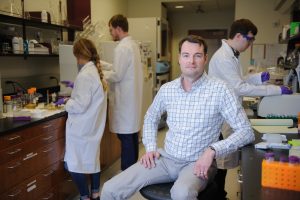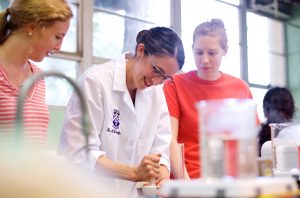
From the April 2018 Desktop News | A key to combating the rise of bacteria with resistance to antibiotics is grasping how bacteria ward off the drugs.
With a new grant from the National Institutes of Health, researchers at The University of Alabama and Spring Hill College hope their study of a common defense mechanism in bacteria will further development of therapies that could give a class of antibiotics a leg up in the microbial battle.
“If we are going to interfere with the resistance process, we need to understand it as a first step to efficiently and effectively disrupting it,” said Dr. Jack A. Dunkle, UA assistant professor of chemistry and biochemistry who is leading the project.
The World Health Organization called antibiotic-resistant bacteria a global health problem in a 2014 report. The U.S. Center for Disease Control estimated in a 2013 report about 2 million people each year become infected with bacteria resistant to antibiotics, killing at least 23,000 people.
Dunkle’s team will examine a mechanism of resistance to macrolide antibiotics. This class of antibiotics includes erythromycin and azithromycin, both designated as essential medicines by the World Health Organization.
Macrolides block bacterial growth by interfering with the microbe’s protein synthesis machinery. Proteins are required for virtually every function of the bacteria’s life cycle, including its metabolism and reproduction.
Resistant bacteria possess a gene that codes for a protein termed the erythromycin resistance methyltransferase, an enzyme that adds a single carbon to the ribosome at the site where the macrolide antibiotics bind. This changes the shape of the site, crowding out the drug’s ability to bind.
This ability is a multi-drug resistance mechanism, causing resistance to three classes of antibiotics in addition to macrolides.
“When a patient is infected by a bacterium harboring the erythromycin resistance methyltransferase, no dose of macrolide antibiotic will cure the infection,” Dunkle said.
The team wants to see how to block the resistance gene to make the bacteria sensitive to the antibiotic again, he said.

“We’re looking for the Achilles heel, a weak spot in the protein, that we could manipulate that would allow the drug to work,” Dunkle said. “If you can interfere with the resistance, you can make the antibiotic work again. You could co-administer a macrolide antibiotic with an inhibitor of the methyltransferase to restore efficacy.”
Also on the project is Dr. Allyn Schoeffler, an assistant professor of chemistry at Spring Hill College in Mobile. Interested in protein-structure function in her own work, Schoeffler will analyze the 3-D structure of the erythromycin resistance methyltransferase in action using high-powered X-rays at the Stanford Synchrotron Radiation Lightsource, a state-of-the-art scientific facility run jointly by Stanford University and the United States Department of Energy.
In Dunkle’s lab, researchers hope the data reveal new ways of blocking resistance.
“Our goal is to understand how it works, and, in that process, we think we will generate information that will be useful for a drug discovery program focused on inhibiting the resistance mechanism,” Dunkle said.
The grant will help students from both institutions work on the project in Dunkle’s lab.
“I’m thrilled to have this opportunity to give Spring Hill College undergraduates the chance to participate in cutting edge research at The University of Alabama,” Schoeffler said. “This is an exciting opportunity to strengthen the scientific ties between our two institutions.”